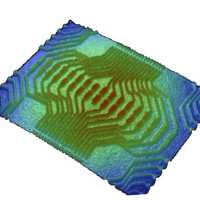Carbon Nanostructures
 Carbon nanostructures include various low-dimension allotropes of carbon including carbon nanotubes, the C60 family of buckyballs, polyaromatic molecules and graphene. Our research focuses first on synthesising well-controlled materials and molecules tailored to specific applications such as high-strength nanocomposites and electronic transport. Second, we wish to further our understanding of those novel materials with the help of theoretical calculations and to assess their safety through detailed studies of their impact on health and the environment.
Carbon nanostructures include various low-dimension allotropes of carbon including carbon nanotubes, the C60 family of buckyballs, polyaromatic molecules and graphene. Our research focuses first on synthesising well-controlled materials and molecules tailored to specific applications such as high-strength nanocomposites and electronic transport. Second, we wish to further our understanding of those novel materials with the help of theoretical calculations and to assess their safety through detailed studies of their impact on health and the environment.
Professor of Materials Chemistry with the Nanostructured Materials and Devices Research Section, Department of Chemistry.
Research focuses on the synthesis and applications of high aspect nanomaterials, particularly carbon nanotubes and graphenes, but including systems based on titania, zinc oxide, and layered double hydroxides. These materials are processed into hierarchical assemblies and composites for structural and functional applications
| Name | Title |
|---|---|
|
Royal Society University Research Fellowship, Department of Materials Research focuses on the synthesis of these materials, developing tunablity of their characteristics, and on the fabrication of devices based on planar structures and on highly porous 3D hierarchical structures where a diverse range of assembly methods is employed. |
|
|
Professor, Chair of Computational Materials Science, Department of Chemistry Research interests lie in the area of quantum mechanical modelling of material properties with the aim of discovering new functional materials. |
|
|
Professor of Theory & Simulation of Materials, Department of Materials and Physics Research interests focus on the development of new linear-scaling methods forperforming large-scale first-principles quantum-mechanical simulations and their application to materials science, nanotechnology and biological systems. |
|
|
Reader in Functional Molecular Materials, Department of Materials Current research directions are focused on magnetic properties of molecular thin films, spintronic applications, novel fabrication methods for oxides, detailed structural characterisation of films and interfaces, and nanowire devices. |
|
|
Reader in the Theory & Simulation of Materials, Department of Materials Current research interests cover the dynamics of electrons out of equilibrium, and the thermodynamics of complex interfaces. |
|
|
Reader in Soft Matter, Department of Chemical Engineering - focus on polymers and microfluids Research interests are in soft condensed matter, in particular in complex polymer mixtures, multicomponent systems, often containing particles and copolymers. currently studying the thermodynamics and dynamics or polymer blends with a combination of real- and reciprocal-space techniques, including microscopy and AFM, and light, X-ray and neutron scattering. |
|
|
Professor of Biomedical Sciences, Department of Surgery and Cancer, Faculty of Medicine Research interests is structural biology and structural genomics/proteomics. |
|
|
Research Officer in Thin Film Technology, Department of Materials |
|
|
Assistant Director of the CDT in Theory and Simulation of Materials, and Director of the Thomas Young Centre for Theory and Simulation, Department of Materials Research is dedicated to the development and application of first-principles modelling tools for the theory and simulation of materials |
|
|
Professor, Chair in Ceramic Engineering, Department of Materials Research looks at the relation between processing, properties and microstructures in a broad range of ceramics. |
|
|
Professor in Bioimaging & Analysis, Department of Materials Has extensive experience in using state-of-the-art analytical, aberration corrected high resolution and 3D electron microscopy techniques to image interfaces between radiation sensitive organic and inorganic materials. |
|
|
Professor of Materials Chemistry with the Nanostructured Materials and Devices Research Section, Department of Chemistry. Research focuses on the synthesis and applications of high aspect nanomaterials, particularly carbon nanotubes and graphenes, but including systems based on titania, zinc oxide, and layered double hydroxides. These materials are processed into hierarchical assemblies and composites for structural and functional applications |
|
| Felice Torrisi |
A Lecturer in 2D materials and Wearable Electronics in the Department of Chemistry and Fellow of Trinity College, Cambridge. Research interests cover printed and flexible electronics graphene and 2D materials, with particular focus on energy, sensing, wearable electronics and bioelectronics. He also works on photonic nanomaterial-polymer composites for Visible, Mid-IR and THz optical modulation and mode-locking. |


